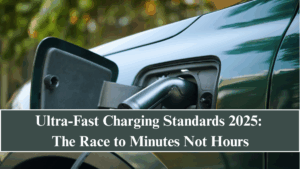As electric vehicles (EVs) continue to dominate the automotive landscape in 2025, one factor defines consumer adoption more than ever: charging speed. The introduction of ultra-fast charging standards is revolutionizing how we perceive EV convenience, turning multi-hour waits into 5–10 minute top-ups. With 800V architecture, high-power DC chargers, and global standardization efforts, the industry is entering a new era where range anxiety may finally become obsolete.

The Evolution of EV Charging Technology
Traditional 400V charging systems served early EVs adequately but fell short as batteries grew larger and more efficient. Now, automakers are embracing 800V platforms (and even 900V+ in development), which enable higher current flow with less heat loss, allowing EVs to add hundreds of kilometers in minutes.
Brands like Porsche (Taycan), Hyundai (IONIQ 6), and Lucid Air already showcase this leap, with up to 350 kW charging capabilities. As battery chemistry improves, these systems are not only faster but also safer and more durable, ensuring longer life cycles.
Global Push for Standardization
The ultra-fast charging landscape is rapidly consolidating around a few key standards:
-
CCS (Combined Charging System): The global favorite, supporting up to 500 kW in the latest updates.
-
NACS (North American Charging Standard): Adopted by Tesla and now major U.S. automakers, unifying the charging ecosystem.
-
CHAdeMO (Japan): Still prevalent but transitioning toward high-voltage compatible models.
The ISO 15118 Plug & Charge protocol further enhances this ecosystem by allowing automatic authentication and payment, making charging as simple as plugging in.
Infrastructure Expansion: Meeting the Demand
Governments and private players are racing to deploy ultra-fast chargers along highways, urban centers, and commercial hubs.
-
Europe: The EU’s AFIR regulations mandate chargers every 60 km on major roads.
-
India: Plans are underway for 1,000+ fast-charging hubs with 250 kW+ stations by 2025.
-
United States: The NEVI program is funding nationwide 350 kW networks across key corridors.
The result? Long-distance EV travel is becoming seamless — no more route planning anxiety, just quick pit stops akin to fueling traditional vehicles.
The Science Behind 800V Architecture
An 800V battery system cuts charging time by increasing voltage and reducing current. The benefits are multifold:
-
Higher efficiency: Less energy lost as heat.
-
Smaller cables: Lower weight and reduced cooling needs.
-
Better scalability: Compatible with future 1000V+ systems.
Manufacturers like Kia, Hyundai, and Audi are standardizing on 800V, while Mercedes-Benz and Rivian are developing 900V+ variants for next-generation EVs.
Environmental and Economic Impact
Ultra-fast charging contributes directly to sustainability goals by making EV adoption more practical for all demographics. Faster charging reduces the need for oversized battery packs, which in turn lowers raw material demand (like lithium and cobalt).
Additionally, high-efficiency chargers integrated with renewable grids and energy storage systems reduce load stress, enabling smart, sustainable energy cycles — an essential step toward carbon-neutral mobility.
Key Challenges Ahead
Despite its promise, ultra-fast charging faces challenges:
-
Infrastructure cost: High-power DC chargers cost 10–15× more than regular AC chargers.
-
Grid strain: Large-scale simultaneous charging can overload regional grids.
-
Battery wear: Frequent ultra-fast sessions may reduce long-term battery health if not managed intelligently.
AI-based thermal management and solid-state battery advancements are actively addressing these hurdles, ensuring both efficiency and safety.
Future Outlook: Charging in Minutes
By late 2025, we can expect charging sessions under 5 minutes for 300+ km range thanks to:
-
1 MW high-power charging standards under IEC revision.
-
Advanced cooling systems with liquid-cooled cables.
-
Next-gen silicon carbide (SiC) inverters enhancing efficiency.
In essence, charging an EV will soon feel like refueling a car — only smarter, cleaner, and cheaper.
FAQs
What makes ultra-fast charging different from normal charging?
Ultra-fast charging operates on 800V+ systems with 350–1000 kW power, enabling vehicles to charge in under 10 minutes, compared to hours on standard chargers.
Which cars support 800V charging in 2025?
Models like Porsche Taycan, Hyundai IONIQ 6, Kia EV6, Lucid Air, and Audi e-tron GT all feature 800V platforms.
Are ultra-fast chargers safe for EV batteries?
Yes — with thermal management systems and adaptive current control, ultra-fast chargers maintain battery safety while minimizing wear.
How does 800V improve efficiency?
It reduces current, minimizing heat loss and allowing thinner cables, resulting in faster, more energy-efficient charging.
What’s next after 800V architecture?
The industry is moving toward 900V–1000V+ ultra-charging systems with megawatt-class stations for commercial fleets and high-performance EVs.
Click here to know more.
